Pictured above: Lumpy Bracket (Trametes gibbosa) © Helena Crouch
Leader Alan Rayner
Seventeen Bath Nats members gathered outside the classroom at Friary on a cloudy but dry, rather breezy morning, to be treated to coffee and cake served by hosts Penny and Richard Williamson as well as a labelled display of fungi that I had gathered locally the previous afternoon.
Suitably refreshed and informed, we then set off and explored some nearby log piles, where clumps of Velvet Shank (Flammulina velutipes) provided a shiny splash of fiery colour. Ascending the lane towards the A46 we saw a good variety of fungi of which the star attraction, quite literally, were some pristine Sessile Earthstars (Geastrum fimbriatum) just in the process of emerging out from a bank. Other species on the road bank included glistening Ivory Waxy Caps (Hygrophorus eburneus) and a patch of Pearly Parachutes (Marasmius wynneae). We returned to the classroom for a lovely lunch, which we enjoyed in a convivial circle seated outside.
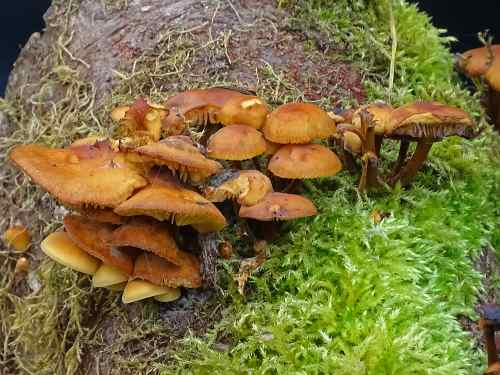
Velvet Shank (Flammulina velutipes) © John Garrett
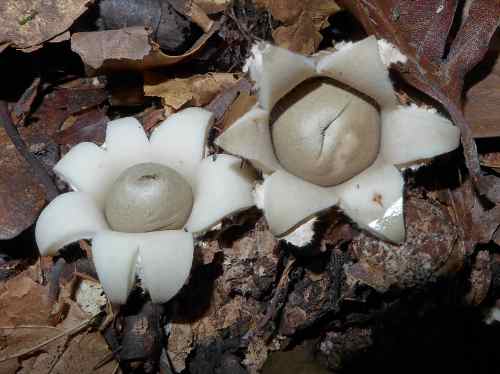
Sessile Earthstars (Geastrum fimbriatum) © Helena Crouch
The afternoon began with a steep ascent up the path to the beech woodland north-west of Friary where we found some beautiful Inky Mushrooms (Agaricus moelleri), staining bright yellow at the base of the stem, and a troop of large Webcaps (Cortinarius spp).
Returning to Friary, we assembled under a large beech tree and examined a troop of Beech Knights (Tricholoma sciodes) growing with Poison Pie (Hebeloma crustuliniforme) before setting off along the path south-east into a mixed deciduous and coniferous woodland. Here we found some more colourful fungi, including Sulphur-tuft (Hypholoma fasciculare), a Rosy Bonnet (Mycena rosea), a Tawny Funnel (Paralepista flaccida), some pretty Lilac Fibrecaps (Inocybe lilacina) and a pair of red-blushing Shaggy Parasols (Chlorophyllum rhacodes).
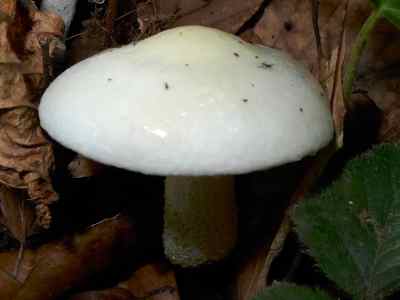
Ivory Waxy Caps (Hygrophorus eburneus) © Helena Crouch
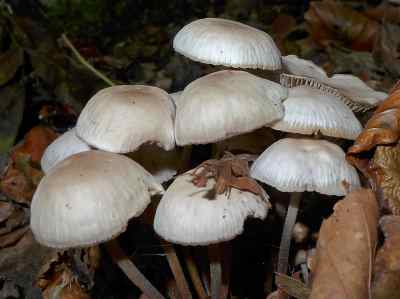
Pearly Parachutes (Marasmius wynneae) © Helena Crouch
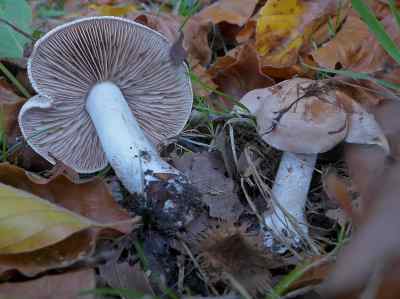
Poison Pie (Hebeloma crustuliniforme) © Helena Crouch
The meeting concluded around 3.20 pm with an expression of thanks to our hosts. It had been a good day and for me it was great to meet some new as well as many old friends who I have missed seeing over the last 18 months.
Alan Rayner
Display of fungi gathered locally the previous afternoon by Alan Rayner. Click the link for a poetic interpretation of this photo by Alan on the Medium website. Somethingness and Nothingness: The Natural Inclusion of Each in the Otherness | by Alan Rayner | Oct, 2021
List of fungi seen (recorded by Helena Crouch)
We set off from the classroom and stopped to see
Armillaria gallica (Bulbous Honey Fungus), probably
On a pile of logs we saw
Chondrostereum purpureum (Silverleaf Fungus)
Flammulina velutipes (Velvet Shank)
Walking up the lane towards the A36 we saw:
Rhytisma acerinum (Sycamore Tarspot) a biotroph on Sycamore
Mycena inclinata (Clustered Bonnet) on a log
Trametes gibbosa (Lumpy Bracket) on a log, pictured at top of page
Melanoleuca polioleuca (Common Cavalier) with white emarginate gills
Hypoxylon fragiforme (Beech Woodwart) on a beech log
Trametes versicolor (Turkeytail) on a beech log
Biscogniauxia nummularia (Beech Tarcrust) black crust on a beech log
Xylaria hypoxylon (Candlesnuff Fungus) on a beech log
On the bank of the lane we saw:
Hygrophorus eburneus (Ivory Waxy Cap)
Neobulgaria pura (Beech Jellydisc) on a log
Geastrum fimbriatum (Sessile Earthstar)
Parasola conopilus, formerly Psathyrella conopilus (Conical Brittlestem)
Geastrum triplex (Collared Earthstar)
Gymnopus peronatus, formerly Collybia peronata (Wood Woollyfoot)
Mycena pura(Lilac Bonnet) smelling of radishes
Hebeloma crustuliniforme (Poison Pie)
Marasmius wynneae (Pearly Parachute)
We returned to the classroom for a delicious lunch provided by Penny and Richard then explored along the path to the NW of Friary through woods, finding:
Agaricus moelleri (Inky Mushroom) which stains yellow and smells of phenol
Cortinarius sp (a Webcap), these are often very toxic
Hypoxylon rubiginosum (Rusty Woodwart) on wood
Tricholoma sp (a White Knight) in a large group by the path
Lycoperdon pyriforme (Stump Puffball) with mycelial cords
Mycena galericulata (Common Bonnet)
Gymnopus confluens, formerly Collybia confluens (Clustered Toughshank)
Daldinia concentrica (King Alfred’s Cakes)
We returned to Friary and assembled by a large beech where we saw:
Tricholoma scioides (Beech Knight) in a group, mycorrhizal with the beech
Hebeloma crustuliniforme (Poison Pie) again
We then followed the footpath into the woods to the SE of Friary and found:
Agaricus comtulus (Mini Mushroom) smelling of aniseed
Megacollybia platyphylla (White-laced Shank)
Hypholoma fasciculare (Sulphur-tuft)
Inocybe geophylla var. lilacina (Lilac Fibrecap)
Paralepista flaccida (Tawny Funnel)
Chlorophyllum rhacodes (Shaggy Parasol) which blushes when bruised
Rhodocollybia butyracea (Butter Cap)
Mycena rosea (Rosy Bonnet)
Inocybe geophila (White Fibrecap)
Coniophora puteana (Wet Rot Fungus) on a log


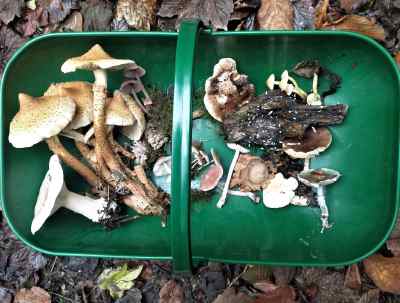
Recent Comments